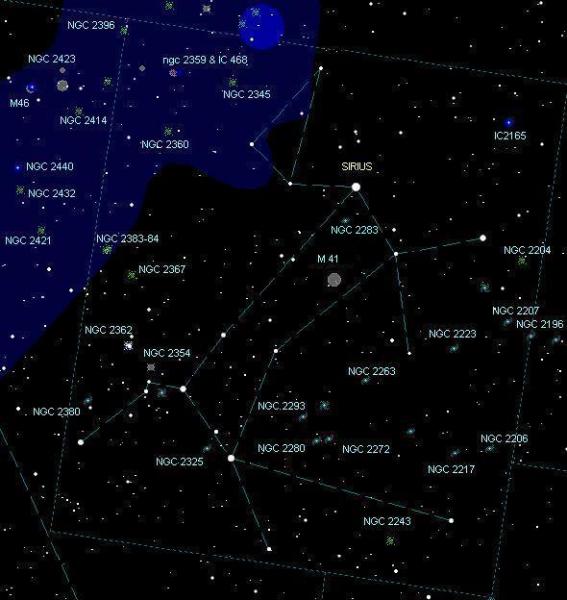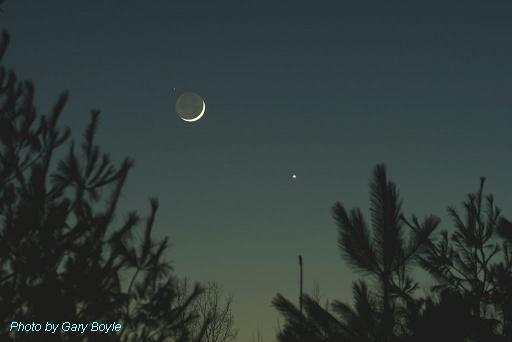Canis Major
Many of our nightly constellations are bright enough to be located from semi-urban areas without a problem. On the other hand, practice does make perfect when trying to spot dimmer groups such as Cancer the Crab, the Little Dipper along with other fainter shapes. However, when it comes to Canis Major – one of Orion’s hunting dogs, there is no denying as to its location in the sky.
The second closest star other than our Sun is named Sirius and easily lights the way to our K-9 friend. Residing a mere 8.6 light-years distance, its beacon glows at magnitude minus 1.5. Orion’s other dog is named Canis Minor with its brightest component called Procyon and resides 11.4 light-years from us.
The name Sirius (aka the Dog Star) is derived from the Greek word for "searing" or "scorching," and seeing this bright sun in a telescope, secures its name. Sirius is also a member of the winter triangle which also encompasses the stars Procyon and Betelgeuse. Sirius is actually a double star system with its companion called Sirius B. This tiny sun orbits extremely close to the parent star but is some 10,000 times fainter. In Its 50 year obit, the companion swings as close as 8 astronomical units (au) and as far as 30 au. I have had the good fortune in spotting the B component in 1982 when the two were a good distance apart and using a grading in front of the eyepiece of the Montreal Centre’s eight-inch Celestron telescope.

Canis Major possesses a wealth of celestial treats within its boundaries. As we begin with the rich open cluster located about four degrees (eight lunar widths) from Sirius. You have found M 41 which was discovered by either Caroline or William Herschel in February of 1785. M41 lays an estimated 2,300 light-years away and measures some 25 ly across itself, sparkles at naked eye magnitude 4.5. It is truly a wonderful object in binoculars as well as a low powered telescope with 25 bright stars and many fainter ones existing in the same area as the full Moon (half a degree) or the size of your pinky nail stretched out at arm’s length.
Sitting between these two bright objects is a 13th magnitude galaxy going by the name NGC 2283. This bit of a challenge measures 3.7 x 2.8 arc minutes in size and floats in front of a rich starfield. We will next look at NGC 2204. Sitting about 8,600 ly it glows at magnitude 8.6. A little less than seven degrees NW from our guidepost Sirius is a 10.6 magnitude planetary. NGC 2165 looks like your everyday planetary with a brighter centre.
NGC 2359 also known as Thor’s Helmet is a combo reflection and emission nebula. This complex bubble glows at magnitude 11 and covers about a quarter of the full Moon. Moving to the dog’s head look for a 7.7 magnitude open cluster known as NGC 2345 – can’t forget that easy number. And you shouldn’t as this collection of 8th to 10 magnitude suns take on the shape of an arrowhead. It takes up a little less than half a lunar width of sky.
Another fine open cluster of suns is NGC 2217. This magnitude 10.4 face-on galaxy has a bright core which is evident but the ring circling it is too faint to be seen visually. On the subject of strange-looking galaxies, NGC 2207 is an interaction of this one and IC2163. These two are located about 140 million ly away with the interaction commencing some 40 million years ago. A really pretty double open star cluster belongs to NGC 2383 / NGC 2384. Almost resting on the Puppis border, these two are 8th and 7th magnitudes respectively.
This is also the month of planets. Look for brilliant Venus in the western sky just after sunset. It is an unmistakable beacon in that area. The solar system’s innermost planet – Mercury will rise to its highest eastern elongation of 18 degrees on the night of Feb 7th and will appear to the lower right of brilliant Venus. To accent the portrait, the planet Uranus will flank Venus by a half a degree to the upper right. Uranus is about 6th magnitude and should be picked up in binoculars when skies darken.
The ringed marvel Saturn is at opposition on Feb 10th thus appearing at its brightest and closest for 2007. Saturn rises at sunset and transits high in the sky at midnight. Even at this closest approach, Saturn will still be 8.2 astronomical units from Earth or 1.2 billion kilometres. Jupiter greets us early in the morning, very low in the southern section of the sky. The bright orange coloured star Antares is some seven and a half degrees to the lower right of Jupiter – the king of planets.
If you missed the conjunction of the thin crescent Moon and Venus on January 20th, you will have another chance on Feb 19th when the Moon will only be 2.58 days old producing a fantastic photographic opportunity. Just four nights later on the 23rd, the almost first quarter Moon will play tag with the Pleiades. This event will best be viewed in the northeast of North America.
For a look ahead to next month, the total eclipse of the Moon will occur on Saturday, March 3rd and will be eclipsed as it rises for most of the east coast of North America with the eastern half of the country seeing the conclusion of the event.
Until next month – clear skies everyone,
Gary Boyle

| Object | Type | Magnitude | RA | DEC |
|---|---|---|---|---|
| IC 2165 | Nebula | 13.0 | 6h 22m | -12d 59m |
| M 41 | Dense open cluster | 4.5 | 6h 46m | -20d 44m |
| NGC 2204 | Rich open cluster | 8.6 | 6h 16m | -18d 39m |
| NGC 2206 | Round galaxy | 13.0 | 6h16m | -26d 46m |
| NGC 2207 | Round galaxy | 10.7 | 6h 16m | -21d 22m |
| NGC 2217 | Elongated galaxy | 10.4 | 6h 22m | -27d 14m |
| NGC 2223 | Round galaxy | 11.4 | 6h 24m | -22d 50m |
| NGC 2243 | Faint open cluster | 9.4 | 6h 30m | -31d 17m |
| NGC 2263 | Elongated galaxy | 13.0 | 6h 38m | -24d 49m |
| NGC 2272 | Round galaxy | 11.9 | 6h43m | -27d 27m |
| NGC 2280 | Elongated galaxy | 12.0 | 6h 45m | -27d 38m |
| NGC 2293 | Round galaxy | 13.0 | 6h 48m | -26d 45m |
| NGC 2325 | Elongated galaxy | 11.2 | 7h 03m | -28d 42m |
| NGC 2343 | Rich open cluster | 6.7 | 7h 08m | -10d 39m |
| NGC 2345 | Rich open cluster | 7.7 | 7h 08m | -13d 10m |
| NGC 2354 | Rich open cluster | 6.5 | 7h 14m | -25d 44m |
| NGC 2359 | Nebula | --- | 7h 18m | -13d 12m |
| NGC 2360 | Dense open cluster | 7.2 | 7h 18m | -15d 37m |
| NGC 2362 | Dense open cluster | 4.1 | 7h 19m | -24d 57m |
| NGC 2367 | Rich open cluster | 7.9 | 7h 20m | -21d 56m |
| NGC 2380 | Round galaxy | 13.0 | 7h 24m | -27d 31m |
| NGC 2383 | Dense open cluster | 8.4 | 7h 25m | -20d 56m |
| NGC 2396 | Rich open cluster | 7.0 | 7h 28m | -11d 45m |
